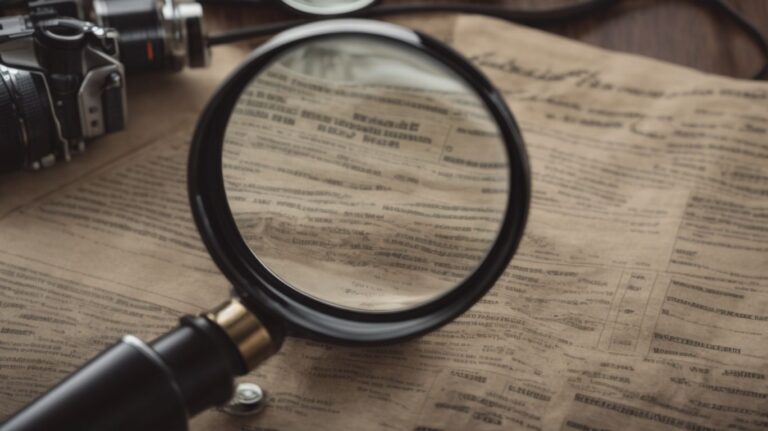Eyewitness testimony plays a crucial role in criminal cases, but how reliable is it really? From the factors that affect its accuracy to the different types of eyewitness identification, this article will provide valuable insights into the psychology behind eyewitness testimony.
We’ll explore common errors in eyewitness testimony, as well as ways to improve its reliability through proper interview techniques, lineups, and expert testimony. We’ll delve into the legal implications of eyewitness testimony and its impact on criminal cases and eyewitnesses.
Contents
- 1 Key Takeaways:
- 2 What Is Eyewitness Testimony?
- 3 How Reliable Is Eyewitness Testimony?
- 4 What Are the Different Types of Eyewitness Testimony?
- 5 What Are the Common Errors in Eyewitness Testimony?
- 6 How Can Eyewitness Testimony Be Improved?
- 7 What Are the Legal Implications of Eyewitness Testimony?
- 8 Frequently Asked Questions
- 8.1 What is eyewitness testimony and why is it important?
- 8.2 What factors can influence the accuracy of eyewitness testimony?
- 8.3 How does the psychology behind eyewitness testimony affect its reliability?
- 8.4 What is the role of suggestibility in eyewitness testimony?
- 8.5 How can the use of leading questions impact the accuracy of eyewitness testimony?
- 8.6 What can be done to improve the reliability of eyewitness testimony in the legal system?
Key Takeaways:
What Is Eyewitness Testimony?
Eyewitness testimony refers to the account given by individuals of an event they have witnessed.
This form of evidence is crucial in legal proceedings and has a significant impact on the outcome of court cases. Research has shown that memory plays a key role in the accuracy of eyewitness testimony, as recollection may be influenced by various factors such as stress, attention, and the presence of weapons.
Psychologists have delved into the complexities of memory and have discovered that the brain’s cognitive processes contribute to the storage and retrieval of these memories, shedding light on why eyewitness testimony can sometimes be unreliable.
How Reliable Is Eyewitness Testimony?
The reliability of eyewitness testimony has been a subject of substantial debate and scrutiny within the field of psychology and legal studies.
Studies have shown that memory can be influenced by various factors, including misleading information and anxiety.
The phenomenon of weapon focus, where individuals focus on a weapon during a crime rather than the perpetrator, can impact the accuracy of eyewitness accounts.
Stressful situations may result in memory distortions, affecting the reliability of testimony.
These complexities highlight the need for careful consideration of eyewitness evidence in legal proceedings.
What Factors Affect the Reliability of Eyewitness Testimony?
The reliability of eyewitness testimony is influenced by a myriad of factors rooted in cognitive psychology and human memory processes.
Memory reconstruction plays a crucial role in shaping the accuracy and consistency of eyewitness testimony. Studies have shown that memories are susceptible to reconstruction and distortion, especially when influenced by external factors such as leading questions or post-event information.
When exposed to leading questions, eyewitnesses may unknowingly alter their memories to align with the suggested information. This phenomenon, known as memory distortion, can significantly affect the reliability of their testimonies, leading to potential inaccuracies in their recollections.
Cognitive psychological mechanisms, including source monitoring and schema activation, impact the encoding and retrieval processes of memories. These mechanisms can influence the formation and distortion of eyewitness testimony, adding another layer of complexity to its reliability.
What Are the Different Types of Eyewitness Testimony?
The landscape of eyewitness testimony encompasses various types of identification, each with distinct characteristics and implications.
Positive identification involves a witness confidently recognizing a suspect as the perpetrator. This form of testimony is generally considered strong evidence due to the certainty expressed.
On the other hand, negative identification occurs when a witness states with confidence that the suspect is not the perpetrator, providing valuable exculpatory evidence. Inaccuracies in identification can lead to wrongful convictions, highlighting the complex nature of eyewitness testimony.
Positive Identification
Positive identification in eyewitness testimony denotes the explicit recognition or affirmation of an individual as the perpetrator or participant in a specific event.
Such identifications carry substantial weight in legal proceedings, often shaping the course of case events and influencing the decisions of the judiciary.
The accuracy and reliability of positive identifications can be subject to various factors, including memory distortion, lineup procedures, and contextual biases. In many cases, individuals may exhibit confidence in their identification, but it’s essential to recognize the potential impact of external influences on their recollection.
Addressing the complexities of positive identification in eyewitness testimony is crucial to ensure just and fair legal outcomes.
Negative Identification
Negative identification in eyewitness testimony pertains to instances where individuals assert the absence of recognition or association with the events under scrutiny.
Such mistaken identifications can significantly impact the outcome of legal proceedings and have sparked extensive research and legal reforms to address this issue.
Eyewitness misidentification is one of the leading causes of wrongful convictions, prompting the integration of safeguards such as lineup procedures, expert testimonies, and jury instructions to minimize the likelihood of erroneous identifications.
Inaccurate Identification
Inaccurate identification within eyewitness testimony encompasses instances where the provided accounts or identifications do not align with the factual reality of the events.
This can occur due to various factors, including the lineup procedures used during identification processes, inherent biases that impact the recollection of events, and the influence of post-event discussions on memory.
Eyewitness lineup procedures can sometimes introduce elements of suggestiveness, potentially leading witnesses to make inaccurate identifications. Cognitive and social biases can influence the way individuals interpret and recall events, leading to discrepancies in their testimonies.
Post-event discussions among witnesses can inadvertently alter their recollections, further complicating the accuracy of eyewitness testimony.
What Are the Common Errors in Eyewitness Testimony?
Despite its significance, eyewitness testimony is susceptible to a range of common errors that can significantly impact its accuracy and reliability.
One prevalent error associated with eyewitness testimony is misidentification, where witnesses incorrectly identify the perpetrator or events. This could be influenced by various factors such as stress, weapon focus, or the cross-race effect.
Memory distortion, another common error, occurs when witnesses unconsciously alter their memories due to post-event information or the mere passage of time. Suggestibility plays a significant role, as witnesses may be influenced by leading questions or other individuals’ misperceptions, impacting the overall reliability of their testimony.
Misidentification
Misidentification in eyewitness testimony refers to instances where individuals incorrectly identify a person or element involved in a given event.
This phenomenon has been extensively studied by researchers such as Loftus and Palmer, who demonstrated the fallibility of memory through their groundbreaking experiments.
The Yerkes-Dodson Curve, which illustrates the relationship between arousal and performance, offers valuable insights into the impact of heightened emotional states on the accuracy of identification.
The influential work of Clifford Scott has shed light on the complex interplay of perceptual factors that contribute to misidentification, further enriching our understanding of this intricate process.
Memory Distortion
Memory distortion within eyewitness testimony encompasses the alteration or misrepresentation of witnessed events due to cognitive and psychological processes.
This phenomenon has been extensively studied, notably exemplified in Sir Frederic Bartlett’s pioneering work on schema theory through his renowned experiment ‘War of the Ghosts.’
Bartlett’s research emphasized the reconstructive nature of memory, showing how individuals tend to fill in gaps and fabricate details in line with their cultural norms and previous experiences.
Dr. Gary L. Wells and Dr. Nancy K. Steblay built on this concept, presenting insights into the misinformation effect, which illustrates how exposure to misleading information can distort recollections.
Dr. John C. Yuille and Dr. Gary L. Wells’s pioneering meta-analysis highlighted the impact of weapon focus, a cognitive phenomenon that leads to diminished accuracy in identifying perpetrators when a weapon is involved.
Suggestibility
Suggestibility in eyewitness testimony pertains to the susceptibility of individuals to external influences or suggestions that can alter their recollection of witnessed events.
This phenomenon has been extensively studied in the field of psychology and criminology. Allport & Postman’s classic study on the topic demonstrated the impact of suggestion on memory recall through their famous ‘War of the Ghosts’ experiment. Their findings highlighted how suggestion can distort the memory of an event over time and through retelling, providing valuable insight into the fallibility of human memory.
To counteract the impact of suggestibility, cognitive interviews have been developed as an effective method for eliciting accurate information from witnesses. These interviews focus on enhancing recall through open-ended questioning, encouraging the retrieval of specific details, and minimizing the potential influence of misleading information.
How Can Eyewitness Testimony Be Improved?
Enhancing the reliability and accuracy of eyewitness testimony necessitates the implementation of targeted strategies and methodologies to mitigate inherent vulnerabilities.
One crucial strategy is the use of proper interview techniques to elicit information from witnesses without introducing bias. This involves conducting open-ended questions and minimizing suggestive language.
The efficacy of lineups and photo arrays plays a vital role in enhancing eyewitness testimony accuracy. Research suggests that sequential lineups and double-blind administration can alleviate issues related to eyewitness misidentification.
The value of expert testimony cannot be understated, as it provides the court with insights into memory and perception, aiding in the understanding of the complexities surrounding eyewitness testimony.
Proper Interview Techniques
Utilizing proper interview techniques is crucial for maximizing the accuracy and reliability of eyewitness testimony, as evidenced by the pioneering work of the Innocence Project and the insights from Vaia’s research at Reed College.
The implementation of proper interview techniques is crucial in obtaining a comprehensive and accurate account of events from eyewitnesses. These techniques also help reduce the risk of misinformation and memory distortions. The increasing use of DNA evidence has highlighted the importance of meticulous interviewing methods, as it has led to the exoneration of wrongfully convicted individuals who were primarily identified by eyewitnesses.
Use of Lineups and Photo Arrays
The utilization of lineups and photo arrays represents an essential mechanism for refining the accuracy and reliability of eyewitness testimony, evident in cases such as that of Ronald Cotton and Jennifer Thompson, as examined by Garrett.
Lineups and photo arrays play a crucial role in the judicial system, aiding in the identification of suspects by eyewitnesses. In the case of Ronald Cotton and Jennifer Thompson, the use of faulty lineups led to an erroneous conviction. This emphasized the need for stringent protocols in conducting lineups to minimize the risk of misidentification and wrongful imprisonment.
Garrett’s research shed valuable light on the shortcomings and biases inherent in eyewitness testimony influenced by suggestive lineups. Understanding these nuances is pivotal for implementing reforms and best practices in criminal investigations. The insights provided by Garrett not only uncovered systemic flaws but also emphasized the pressing need for standardized lineup procedures, ensuring fair and just legal outcomes.
Expert Testimony
The inclusion of expert testimony serves as a pivotal strategy in bolstering the credibility and validity of eyewitness testimony, as demonstrated by the influential contributions of experts such as Cornelius Depree and the seminal work of Caputo & Dunning, as well as Cutler & Penrod.
Expert testimony carries significant weight in legal proceedings and investigative processes. Their specialized knowledge and experience offer crucial insights into human memory, perception, and the factors influencing eyewitness accuracy.
Research by Caputo & Dunning has shed light on the susceptibility of memory to distortions and the impact of external influences on eyewitness accounts, amplifying the significance of expert interpretation. Cutler & Penrod’s comprehensive analysis of the dynamics of eyewitness testimony has highlighted the fallibility of memory, reinforcing the necessity of expert input to navigate its complexities.
What Are the Legal Implications of Eyewitness Testimony?
The legal implications of eyewitness testimony extend into the realm of criminal proceedings, influencing case outcomes, and potentially impacting the lives of the eyewitnesses involved.
As eyewitness testimony is often a crucial element in criminal cases, its reliability and accuracy significantly affect the justice system. The weight given to such testimony and its implications on a case can be immense, potentially determining the guilt or innocence of the accused.
Eyewitnesses themselves may experience significant ramifications, from the emotional strain of the legal process to potential doubts about their own recollections. One of the critical factors influencing eyewitness testimony is the prevalence of biases, such as memory distortion and suggestibility, which can lead to inaccuracies and misinterpretations. These biases often arise from various sources, including external influences, personal beliefs, and environmental factors.
Impact on Criminal Cases
The impact of eyewitness testimony on criminal cases is a subject of substantial scholarly inquiry, as evidenced by the seminal contributions of Wells, Memon, and Penrod in the field of legal psychology.
Research in the realm of legal psychology has progressively unraveled the complex dynamics surrounding eyewitness testimony, shedding light on its significance and potential fallibility in influencing criminal proceedings.
Wells, Memon, and Penrod have delved deeply into the intricate interplay of memory, perception, and suggestibility that characterizes the phenomenon of eyewitness testimony. Their collective body of work has bolstered the understanding of the variables influencing the accuracy and reliability of accounts provided by eyewitnesses, serving to caution against undue reliance on such testimonies.
Impact on Eyewitnesses
The impact of eyewitness testimony on the individuals involved as eyewitnesses represents a critical area of study within the field of psychology and legal studies, as evidenced by the seminal contributions of Brigham, Bornstein, and McGorty.
These scholars have delved deep into the multifaceted effects of eyewitness testimony, examining the intricate dynamics that shape an eyewitness’s memory recall, narrative construction, and susceptibility to external influences.
The insightful research conducted by Brigham, Bornstein, and McGorty has illuminated the far-reaching implications of eyewitness testimonies on legal proceedings, shedding light on the potential biases, errors, and unreliability that might arise.
By analyzing the cognitive processes involved, such as perception, encoding, retention, and retrieval, these influential studies have expanded our understanding of how eyewitness testimony can be both impactful and fallible.
Frequently Asked Questions
What is eyewitness testimony and why is it important?
Eyewitness testimony refers to the information provided by an individual who has witnessed a crime or an event. It is important because it can contribute to the conviction or acquittal of a suspect and can greatly impact the outcome of a trial.
What factors can influence the accuracy of eyewitness testimony?
There are several factors that can influence the accuracy of eyewitness testimony, including stress, the presence of a weapon, cross-race identification, and leading questioning techniques.
How does the psychology behind eyewitness testimony affect its reliability?
The psychology behind eyewitness testimony highlights the fallibility of human memory and perception. Factors such as stress, trauma, and bias can greatly impact the accuracy of an eyewitness’s account of an event.
What is the role of suggestibility in eyewitness testimony?
Suggestibility refers to the tendency of an individual to incorporate information provided by others into their own memories. In the context of eyewitness testimony, this can lead to false or distorted recollections of an event.
How can the use of leading questions impact the accuracy of eyewitness testimony?
Leading questions are worded in a way that suggests a particular answer, which can influence an eyewitness’s recollection of an event. This can lead to the presentation of false information in court and can greatly impact the outcome of a trial.
What can be done to improve the reliability of eyewitness testimony in the legal system?
To improve the reliability of eyewitness testimony, it is important for courts and law enforcement agencies to implement scientifically-backed procedures for conducting eyewitness identifications. This includes using unbiased lineups, minimizing suggestive questioning, and recording eyewitness statements immediately after an event.




